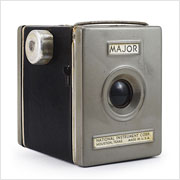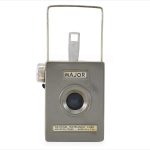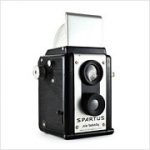National Instrument Corp. Major Specifications
| Manufacturer: | National Instrument Corp. |
| Origin: | USA |
| Made in: | Houston, TX, USA |
| Introduced: | 1947 |
| Type: | Box, Viewfinder |
| Format: | 620 Film |
| Dimensions: | 7 x 9.8 x 9.3 cm |
| 7 x 16.2 x 9.3 cm (viewfinder open) |
National Instrument Corp. Major Overview
The National Instrument Corp. Major is a barebones box camera designed for the 620 film format and introduced by the National Instrument Corporation of Houston, Texas. The Major, alongside the Colonel (virtually identical apart from having flash synchronization capabilities), and the upright Camflex were all introduced at around the same time and were the only known models produced during the manufacturer’s brief foray into the photography industry which makes all three cameras relatively rare and difficult to find.
The Major is quite primitive, even for a box camera. The fixed focus, fixed aperture meniscus lens is mated to a basic single-speed rotary shutter which is triggered by a tiny lever next to the film advance knob on the user’s right-hand side of the camera. Unlike more conventional box cameras like the Kodak Brownie Target or Ansco Shur Shot, the Major has no optical viewfinders and instead relies on a finder which is comprised of a retractable wire frame behind the faceplate and a crude metal eyepiece just above the red window on the back of the camera that can be rotated into place. Absent of hinges, the entire back plate of the camera can be removed to load and unload film. There is no carrying handle or tripod socket.
Although its no-frills stamped metal body, beige color, and the utilitarian typeface used on the front remind me of long, monotonous days at my old accounting job, the thing that most attracted me to the Major was its stark, industrial-looking design which makes it look more like something you’d find in a factory or office building than in someone’s home. True to its manufacturer’s name, the National Instrument Corp. Major comes across as a soulless piece of equipment and not a steward of treasured memories. I still love it, though.
Find your very own National Instrument Corp. Major on eBay.
McKeown, James M. and Joan C. McKeown’s Price Guide to Antique and Classic Cameras, 2001-2002. (Grantsburg, WI, USA: Centennial Photo Service, 2001), p 488.



















